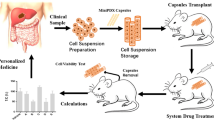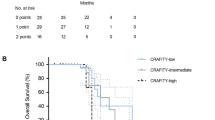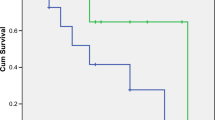Abstract
This study aims to investigate the clinical response of ATP tumor chemosensitivity assay (ATP-TCA) directed chemotherapy regimens delivered via hepatic artery infusion in 104 cases of primary liver carcinoma (PLC). Tumor tissue was obtained via laparotomy and cultivated in vitro. This tissue was put through the assay to determine chemosensitivity. A single drug regimen of either 5-FU, MMC and ADM and a combination drug regimen were used. The treatment assigned was dependent on the result of the ATP-TCA. In the control group, 30 cases of diagnosed PLC were given the conventional three-combination drug. The two groups were evaluated after three courses of chemotherapy. The results are as follows. The overall response rate of sensitivity test ranged from 36% to 44% in the single drug therapy groups and 81% in the combination drug group. The clinical overall response rate was 75% in the treatment group and 56% in control group. The treatment group had better results than the control group as survival period over six months was 80% and over one year 44%. In the control group, survival period over six months was 60% and 30% over one year. In short, ATP-TCA directed chemotherapy shows better results for terminal stages of PLC in that you can decrease the dose of drugs thereby reducing the side-effects with possible improvements in therapeutic effects.
Similar content being viewed by others
References
Petru E, Sevin B U, Perras J, Boike G, Ramos R, Nguyen H, Averette H E. Comparative chemosensitivity profiles in four human Ovarian Carcinoma cell lines measuring ATP bioluminescence. J Gynecol Oncology, 1990, 38(2): 155–160
Sevin B U, Peng Z L, Perras J P, Ganjei P, Penalver M, Averette H E. Application of an ATP-bioluminescence assay in human tumor chemosensitivity testing J. Gynecol Oncology, 1988, 31: 191–204
Ng T Y, Ngan H Y, Cheng D K, Wong L C. Clinical applicability of the ATP cell viability assay as a predictor of chemoresponse in platinum-resistant epithelial ovarian cancer using nonsurgical tumor cell samples. J Gynecol Oncology, 2000, 76: 405–408
Cree I A, Kurbacher C M, Untch M, Sutherland L A, Hunter E M, Subedi, A M, James E A, Dewar J A, Preece P E, Andreotti P E, Bruckner H W. Correlation of the clinical response to chemotherapy in breast cancer with ex vivo chemosemsitivity. Anti Cancer Drugs, 1966, 7: 630
Liu S L, Peng Z L, Lou J Y, Wang H, Tang S P, He B. The exploratory development of ATP bioluminescence in tumor chemosensitivity assay. Hua Xi Yi Ke Da Xue Xue Bao, 2000, 31(3): 330–333
Liu S L, Peng Z L, Wang H, Lou J L, He B, Tang S P, Qiu D S. The counting of living cells by ATP bioluminescence assay, Hua Xi Yi Ke Da Xue Xue Bao, 2000, 31(2): 260–261, 268
Chu Z H, Chen T. The application of ATP-tumor chemosensitivity assay in chemotherapy of primary liver cancer. Chin J Experiment Surg, 2002, 19(3): 235–236
Author information
Authors and Affiliations
Rights and permissions
About this article
Cite this article
Rao, R., Chen, W., Zhou, X. et al. Clinical outcomes of ATP-tumor chemosensitivity assay directed chemotherapy in hepatocellular carcinoma. Front. Med. China 1, 157–160 (2007). https://doi.org/10.1007/s11684-007-0029-z
Received:
Accepted:
Published:
Issue Date:
DOI: https://doi.org/10.1007/s11684-007-0029-z




